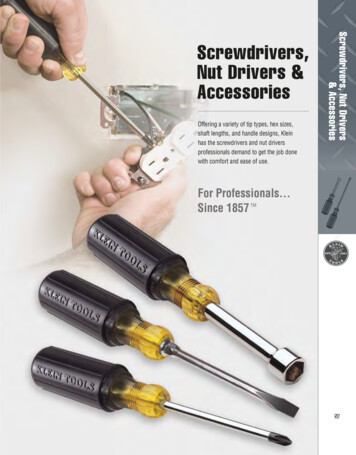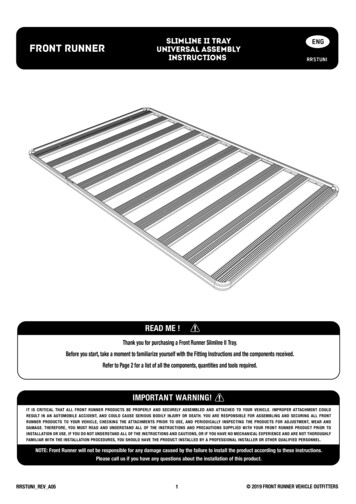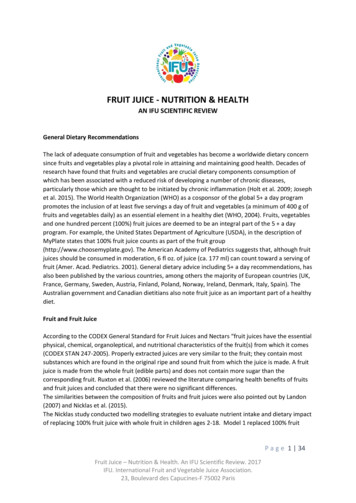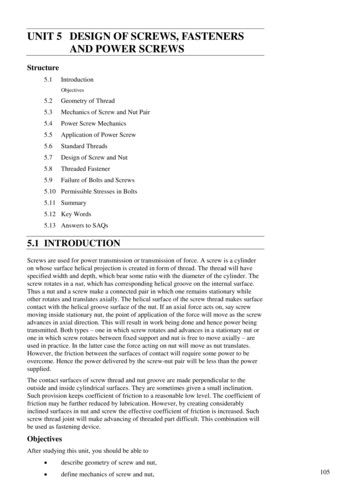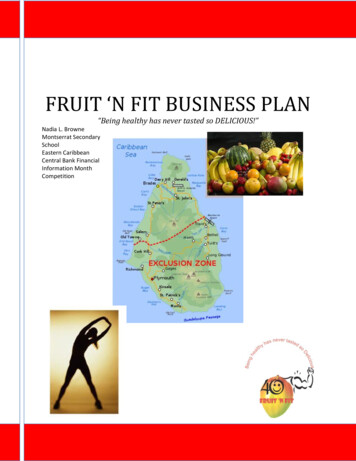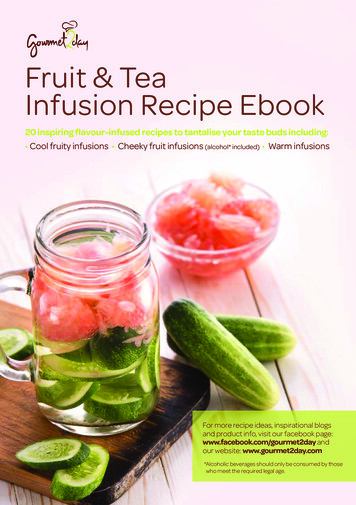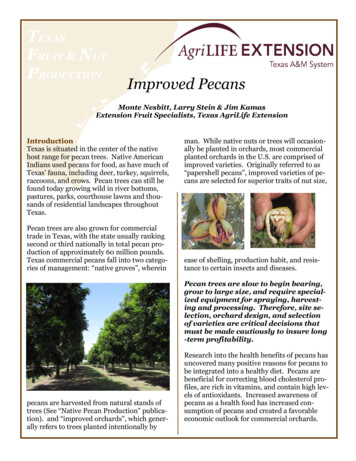
Transcription
TEXASFRUIT & NUTPRODUCTIONImproved PecansMonte Nesbitt, Larry Stein & Jim KamasExtension Fruit Specialists, Texas AgriLife ExtensionIntroductionTexas is situated in the center of the nativehost range for pecan trees. Native AmericanIndians used pecans for food, as have much ofTexas’ fauna, including deer, turkey, squirrels,raccoons, and crows. Pecan trees can still befound today growing wild in river bottoms,pastures, parks, courthouse lawns and thousands of residential landscapes throughoutTexas.Pecan trees are also grown for commercialtrade in Texas, with the state usually rankingsecond or third nationally in total pecan production of approximately 60 million pounds.Texas commercial pecans fall into two categories of management: “native groves”, whereinman. While native nuts or trees will occasionally be planted in orchards, most commercialplanted orchards in the U.S. are comprised ofimproved varieties. Originally referred to as“papershell pecans”, improved varieties of pecans are selected for superior traits of nut size,ease of shelling, production habit, and resistance to certain insects and diseases.Pecan trees are slow to begin bearing,grow to large size, and require specialized equipment for spraying, harvesting and processing. Therefore, site selection, orchard design, and selectionof varieties are critical decisions thatmust be made cautiously to insure long-term profitability.pecans are harvested from natural stands oftrees (See “Native Pecan Production” publication). and “improved orchards”, which generally refers to trees planted intentionally byResearch into the health benefits of pecans hasuncovered many positive reasons for pecans tobe integrated into a healthy diet. Pecans arebeneficial for correcting blood cholesterol profiles, are rich in vitamins, and contain high levels of antioxidants. Increased awareness ofpecans as a health food has increased consumption of pecans and created a favorableeconomic outlook for commercial orchards.
Orchard SizeEstablishing an orchard that is either too bigor too small can result in economic failure. Asingle pecan tree is capable of producing 50 lbsof nuts per tree in the 10th growing season and100 pounds in the 15th growing season. Pecantrees are most frequently planted at densitiesranging from 12 to 48 trees per acre, making itpossible to produce over 1,000 pounds peracre per year. With many varieties requiring50 nuts to make a pound, a single acre of pecans may yield 50,000 nuts which must beharvested. Hobby orchards of one or two acresmay be harvested by hand, without equipment,but serious, commercial endeavors will needthe following equipment items: 1) tractor, 2)tree sprayer, 3) trunk shaker, 4) harvester, and5) cleaner. The cost of the specialized pecanequipment is typically the same for an orchardof ten acres or one hundred (100) acres, thussmall orchards bear higher equipment costsper acre which may challenge profitability ofthe venture.the spring, and it is unusual, although not unthinkable for the flower crop to be damaged byAir-blast type pecan tree sprayerlate spring freezes. Cold pockets that placeplants at higher risk for freeze damage shouldbe avoided for young trees and reduced springfrost damage. The Texas panhandle, and othernorthern counties of the state should considerearly-harvest varieties to avoid fall freeze damage to maturing nuts.Larger orchards must have a cash flow plan forthe establishment phase of the orchard, duringwhich time the trees bear very little crop. Theestablishment phase of a new pecan orchardranges from five to seven years, depending onthe precocity of the improved varieties that areplanted and their vigor on the site. Commercial pecan orchards require approximately 2,000 per acre to bring into production.Sample pecan budgets, including establishment costs may found at http://agecoext.tamu.edu.Counties that generally lie east of Interstate 35are considered part of the East, humid pecangrowing region (Fig. 1). Rainfall in the Eastregion decreases irrigation water pumping requirements, but also has higher incidence ofdiseases (Pecan Scab, Downy Spot) and greaterdifficulty harvesting in rainy years. Pecangrowers in the West region have little concernswith diseases, but must plan to supply almostall of the annual 55 inches of water per acrethat pecan trees require for good growth andproduction.Pecans require 2 inches of water per week oncein production, so water volume and the cost ofdelivering suitable quality water need to beconsidered when determining the size of anorchard. Starting small and expanding inphases is a wise strategy for new pecan growers who are unfamiliar with the nuances of pecan growing.An irrigation system is recommended for allcommercial pecan orchards in Texas. Rainfall,even in the most humid areas, is erratic in distribution, and there are critical times in theseason each year when trees must receiveenough water to grow and fill out the nut. Mature bearing trees require 2 inches per week,and should ideally be irrigated every week orClimateAll areas of Texas are climatically suited to pecans. Pecans require 200 or more frost-freedays to produce a crop on the earliest maturingvarieties. Pecan trees break dormancy late in2
into one of two flowering categories: Type I or“protandrous” (male catkins appearing first);and Type II or “protgynous” (female flowersappearing first). Each pecan orchard shouldcontain both flowering types to insure adequate pollination. The ratio of the two typesdoes not have to be equal. Approximately 15%pollenizers in theorchards shouldprovide adequatepollination of aLipanmain variety, provided that they areuniformly distribPawneeuted throughoutthe orchard. Othervariety characterisKanzatics to study carefully include dateof nut maturity,alternate bearingtendency and Scab resistance in humid regions.Solid set- type sprinkler irrigationat least never be allowed to go longer than 21days without water. Salts in the soil and/or water can significantly reduce growth or kill thetrees in extreme cases. Potential pecan orchardsites or problem orchards need to have theirirrigation wells tested for water volume, quality, and the cost of electricity for pumping thewater. A good rule of thumb is to have a wellcapacity of 10 gallons of water per minute foreach acre of trees.SpacingSpace and ample sunlight are essential formaintaining productivity and profitability.Crowding in pecan orchards is defined aslimbs of adjacent trees touching and/or lessthan 50% of the orchard floor receivingsunlight at mid-day in summertime. Crowdingcauses nut production to decline, nut size todecrease, and alternate bearing to be more severe. Crowding should be prevented ratherthan corrected, by tree removal or canopyhedging. Canopy hedging requires very expensive equipment and thus must be contractedannually by small orchards that cannot affordto purchase equipment. Whereas hedgingmust be performed annually to prevent crowding, tree removal prevents crowding for severalyears, if not permanently.SoilPecan orchards should be established on deepand well drained soils that contain properamounts of air, water and nutrients. Poor soildrainage is one of the most serious limitingfactors in pecan orchards. More orchards failin Texas because of undesirable soil than fromany other factor, and unfortunately, management cannot correct or substitute for soil limitation. Pecan trees can grow on very shallowsoil, but for commercial production of morethan 1,000 pounds per acre, the soil should be32 inches deep or more.VarietiesFigure 1. displays the recommended improvedvarieties for four production regions of Texas.The Texas Pecan Handbook (SP-445) discusses each variety thoroughly. A major consideration in variety selection is how pecansharvested from the orchard will be marketed.Large nut size and bright kernel color is important to retail marketing, while kernel percentage and acceptability to shellers is importantfor wholesale marketing. Pecan varieties fallThe initial tree spacing determines how sooncrowding will occur in a pecan orchard. Manypecan orchards in Texas are planted at a spacing of 30 to 35 feet between trees (30 x 30; 35x 35). Trees at such spacing crowd in 12 to 18years after planting, depending on site, waterand management inputs. Closer spacing is uncommon in Texas due to the fast rate of crowd3
Regional Factors to Consider:North: Shorter growing season; low disease pressure; irrigation required, calcareous soils requiring foliar zinc sprays.West: Low disease pressure; high heat stress; irrigation required, calcareous soils requiringfoliar zinc sprays.Central: Variable disease pressure (usually light); variable soils, supplemental irrigation.East: Moderate to high disease pressure; variable soils, supplemental irrigation.Caddo (I)Lipan (I)**Mandan (I)**Osage (I)Pawnee (I)Kanza (II)Lakota (II)Caddo (I)Cheyenne (I)Lipan (I)**Pawnee (I)Waco (I)Western (I)Hopi (II)**Lakota (II)**Wichita (II)Caddo (I)Desirable (I)Lipan (I)**Mandan (I)**Oconee (I)Pawnee (I)Kanza (II)Lakota (II)**Nacono (II)Sioux (II)Wichita (II)ssApalachee (I)**Caddo (I)Desirable (I)ssLipan (I) **Mandan (I)**Oconee (I)Pawnee (I)ssPrilop (I)Elliott (II)bbForkert (II)Kanza (II)Lakota (II)**Legend:(I) Type I pollination (protandrous) pollen shedfirst.(II) Type II (protognynous) female flowers receptive first.** New and untested variety for trial planting.ss Scab susceptibility risk elevated in this region.bb Breaks dormancy early and should not beplanted in northernmost areas of region
ing that occurs. Wider spacing (50 x 50; 60 x60) is recommended for growers who want toextend the time when crowding preventionmethods will be needed. Where there is a desire for pecan trees to never crowd, theyshould be planted 75 to 100 feet apart or further.Where soils are similar and a large volume ofwater is available, bearing trees up to approximately 8 inches trunk diameter can be movedwith large tree transplanting equipment.Orchard Floor ManagementWeeds must be controlled in young and mature pecan orchards to prevent reduced growthWell spaced young pecan orchardFuture tree removal operations should be considered in the designed layout of main varieties, temporary varieties (if any) and pollenizers. Pollenizers should be located so that theywill be present in the orchard after trees arestrategically removed.“Sod and Strip” orchard flooror kernel development from competition forwater and nutrients. A “Sod and Strip” systemthat combines herbicide use with mowing ofgrass is the most practical and widely used system of orchard floor management. Herbicidesmust be used effectively and properly to killthe weeds, to reduce chemical costs, and toprotect the applicator and the environment.Routine cultivation is practiced in western portions of the state where orchards are flood irrigated. Compaction and erosion are potentialproblems from frequent disking or other cultivation practices.Mature, 30x30 spaced orchard hedgedannually to maintain sunlight.Square, rectangle, and diagonal orchard designs offer different tree removal strategies.These should be considered carefully in planning to prevent crowding.Grazing livestock in improved orchard is practiced in Texas, but it is generally not recommended because of the potential damage toyoung trees, compaction of soil, and interfer5
ence with irrigation, spraying and harvestingpractices.FertilizerNitrogen is essential for good pecan growth. Thefirst application should be at bud break in Aprilwith additional applications in May and June.When extremely heavy crops are set, nitrogenshould also be applied in July and August. As arule, 10 pounds of actual nitrogen are needed for100 pounds of pecans set per acre in June. Thenumber of nitrogen applications should be consistent with crop size. Young trees should receivevery small but frequent applications of nitrogenin response to growth. When fast growth occurs,add additional applications until early June. Potassium fertilizer may be needed once every fiveyears on deep sandy soil if leaf levels fall below1% potassium content. Phosphorous fertilizer istypically not needed in Texas.type to improve uptake into the foliage. Very fastgrowing young non-bearing trees need zincsprays at least every 14 days from bud break inApril to early June. Mature bearing pecan treesrespond best to 5 applications of zinc. The first 3applications should be made one week apart beginning at bud break. A 4th application shouldthen be made 2 weeks later followed by a 5th application 3 weeks later. Zinc sulfate will kill mostother plants if the spray contacts their foliage;consequently, zinc nitrate is preferred for urbanor landscape use.DiseasesPecans are susceptible to a number of foliage,fruit and root diseases in Texas. Pecan Scab isthe most important fungal disease in EasternTexas. Control may require multiple fungicideapplications to the tree canopy each season ifrainfall isprevalent. AllFoliar Zinc Sprays are essential for pecangrowers maygrowth in Texas. Soil or drip system applications encounterof zinc are not effective. Zinc is needed for leafDowny Spot,expansion, so applications should be made frePowdery Milquently in the early portion of the growing season dew, Shuckfor maximum growth. Two products, zinc sulfate Dieback, Stemwettable powder or liquid zinc nitrate, are usedEnd Blight,with equal success. Liquid nitrogen (32% ureaBacterial Leafammonium nitrate) can be added to either zincScorch, amongothers. RootPecan scab on pecan shuckknot nematodes, Cotton Root Rot, and Crown Gall are potential problems in some regions of Texas.Pecan tree exhibiting severe zinc deficiency ;bunchy canopy , small leaves , & limb diebackDamage from pecan nut casebearer larvae6
InsectsInsects are an expected occurrence in Texas pecan orchards. Pecan growers must become familiar with the control strategies for four seriousfruit-attacking pests, as well as numerous foliagefeeders. Borers may attack trunks, limbs androots of pecan trees as well.Integrated Pest Management for pecans is described in the Texas Pecan Handbook, and onthe following esting pecans in Texas must be done expediently to overcome expected delays from inclement weather and minimize depredationfrom varmints and birds (squirrels, bluejays,crows, turkeys). Pecan is very slowly perishable,but sprouting, embryo rot, darkening of kernels,and other problems develop as pecans remain inthe field for many days. Traditionally, the pecanmarket prices become more volatile and may decline as the season extends, giving growersadded incentive to harvest quickly. Mechanicalharvest in commercial orchards is a three or four-step process.1) Trunk shakers put the crop on the ground.2) Harvesters pick up pecans and associatedsticks, leaves and other trash.3) Cleaners separate good pecans from trash.An intermediate step of sweeping or windrowing is performed for certain types of harvesters that are less maneuverable in the orchard.to prevent kernel darkening, embryo rot, vivipary (sprouting), mycotoxins such as aflatoxin,and other problems related to moist pecans.Shucks not removed in the orchard by nature orthe harvesting equipment are removed with dehulling equipment. In south Texas, where harvest is begun before the shucks are fully open toprevent vivipary, the shucks must be ground offin water with special equipment. Once deshucked, poorly filled pecans are vacuum sepa-PTO—powered pecan harvesterMachine-harvested pecans and trash before processingProcessing pecans immediately after harvest isneeded to obtain a good early season price andPTO –powered trunk shakerPecan cleaner and sacking operation7
rated with a pop remover. Good pecans aredried from 15% moisture to only 4% as soon aspossible using forced air. This can be in specialdrying boxes, false bottom peanut trailers, open-weave sacks, or on concrete floors. Drying timeis greatly reduced by moving as much dry airover the pecans as possible.produce from1,000 to 2,000 pounds per acreper year in well managed orchards on goodsites. The pecan market is currently strong andpaying above 1.00 per pound wholesale. However this is a market with a history of volatilityand new growers should proceed with caution,investigating the market outlook for commercialpecans.MarketingCommercial pecan orchards can claim agriculMany pecan growers, particularly smaller pro- tural land tax exemptions; however, since 1986,ducers, direct-market their pecans to the conthere are very limited IRS tax advantages forsumer in a retail store, in a catalog, on the inter- pecans and profits need to be determined on anet, through fund-raising organizations etc. For true cash basis.these growers, pecan prices are set based onconsumer demand for a fresh productInformation on pecan production can be obA wholesale market for pecans, based aroundtained from the "Texas Pecan Handbook" whichapproximately 25 major shelling companies isis available for a fee at the Texas AgriLife Bookavailable to all growers. Price is affected by astore (http://agrilifebookstore.org). The Texasnumber of global economic factors as well as the Pecan Orchard Management Shortcourse isalternate bearing habit of pecan trees, supplytaught annually the last week of January atand demand, supply and cost of competing nuts Texas A&M University in College Station. For(walnuts, almonds) etc. Wholesale prices areregistration information, contact Texas A&Moften lowest when the national crop is large.University Conference Services.Wholesale market price is additionally affectedby variety being sold and the sizing of the nuts, Acknowledgmentsquality of the lot being sold, and presence of de- This document is adapted from “Commercialfects.Pecan Orchards in Texas”, (1997) authorsCommercial growers should learn how to conGeorge Ray McEachern, Larry A. Stein andduct their own “hand test”, which computesJulian W. Sauls.percent kernel by weight, percent fancy grade,and other price-affecting factors. The hand testprocedure is demonstrated in many Texas counties annually as part of the Texas Pecan Showand Grading Demonstration, which culminatesin a state show of the top pecans in Texas, displayed at the Texas Pecan Growers AssociationAnnual Conference (http://www.tpga.org)Costs and Returns for pecans in Texas varygreatly. Of the 67,500 acres of planted orchards,many seldom realize a profit because one orseveral orchard management factors critical tosuccess is deficient. Approximately 2,000 arerequired to bring one acre of pecans into production, not including the cost of the land, irrigation well, or special needs, such as wildlifeproof fencing. Once bearing, 600 per acre arerequired for operating costs; therefore, production needs to exceed 600 pounds per acre if thepecan market price is at least 1.00 per pound.This a reasonable target, since orchards can8
Texas commercial pecans fall into two catego-ries of management: "native groves", wherein pecans are harvested from natural stands of trees (See "Native Pecan Production" publica-tion). and "improved orchards", which gener-ally refers to trees planted intentionally by man. While native nuts or trees will occasion-

